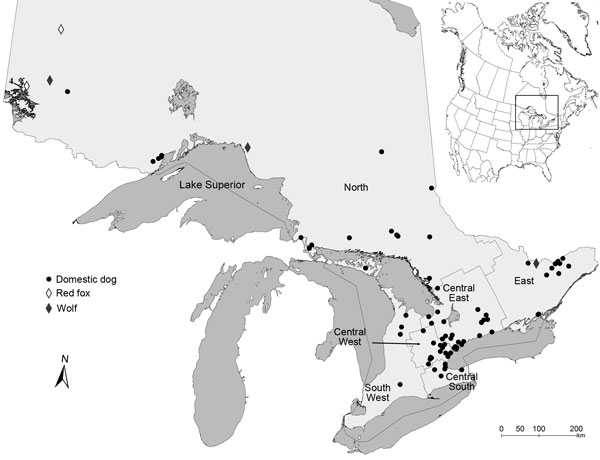Volume 22, Number 7—July 2016
Dispatch
Red Fox as Sentinel for Blastomyces dermatitidis, Ontario, Canada
Figure

Figure. Locations of wild and domestic canids infected with Blastomyces dermatitidis during 1996–2014, Ontario, Canada. Inset map shows the location of Ontario in Canada. Health regions within the province consist of grouped public health units as defined by the Ontario Ministry of Public Health and are named according to Morris et al. (2). Dark gray shading indicates lakes; the Great Lakes are shown in the lower part of the figure.
References
- Kerl ME. Update on canine and feline fungal diseases. Vet Clin North Am Small Anim Pract. 2003;33:721–7. DOIPubMedGoogle Scholar
- Morris SK, Brophy J, Richardson SE, Summerbell R, Parkin PC, Jamieson F, Blastomycosis in Ontario, 1994–2003. Emerg Infect Dis. 2006;12:274–9. DOIPubMedGoogle Scholar
- Kane J, Righter J, Krajden S, Lester RS. Blastomycosis: a new endemic focus in Canada. Can Med Assoc J. 1983;129:728–31.PubMedGoogle Scholar
- Reed KD, Meece JK, Archer JR, Peterson AT. Ecologic niche modeling of Blastomyces dermatitidis in Wisconsin. PLoS One. 2008;3:e2034. DOIPubMedGoogle Scholar
- Lester RS, DeKoven JG, Kane J, Simor AE, Krajden S, Summerbell RC. Novel cases of blastomycosis acquired in Toronto, Ontario. CMAJ. 2000;163:1309–12.PubMedGoogle Scholar
- Litvinov IV, St-Germain G, Pelletier R, Paradis M, Sheppard DC. Endemic human blastomycosis in Quebec, Canada, 1988–2011. Epidemiol Infect. 2013;141:1143–7. DOIPubMedGoogle Scholar
- Davies JL, Epp T, Burgess HJ. Prevalence and geographic distribution of canine and feline blastomycosis in the Canadian prairies. Can Vet J. 2013;54:753–60.PubMedGoogle Scholar
- Dalcin D, Ahmed Z. Blastomycosis in northwestern Ontario, 2004 to 2014. Can J Infect Dis Med Microbiol. 2015;26:259–62 .DOIPubMedGoogle Scholar
- MacDonald PDM, Langley RL, Gerkin SR, Torok MR, MacCormack JN. Human and canine pulmonary blastomycosis, North Carolina, 2001–2002. Emerg Infect Dis. 2006;12:1242–4. DOIPubMedGoogle Scholar
- Rosatte R, Allan M. The ecology of red foxes, Vulpes vulpes, in metropolitan Toronto, Ontario: disease management implications. Can Field Nat. 2009;123:215–20.
- Trewhella WJ, Harris S, McAllister FE. Dispersal distance, home range size and population density in the red fox (Vulpes vulpes): a quantitative analysis. J Appl Ecol. 1988;25:423–34. DOIGoogle Scholar
- DiSalvo AF. Blastomycosis. In: Al-Doory Y, DiSalvo AF, editors. The ecology of Blastomyces dermatitidis. New York: Plenum Medical Book Co.; 1992. p. 42–73.
- McIntyre L. Blastomycosis in northwestern Ontario. Can Fam Physician. 1985;31:161–4.PubMedGoogle Scholar
- Ontario Ministry of Natural Resources. Hunting regulations summary. 2013 [cited 2015 Mar 31]. https://www.ontario.ca/environment-and-energy/2013-furbearing-mammals-seasons-hr-summary
Page created: June 14, 2016
Page updated: June 14, 2016
Page reviewed: June 14, 2016
The conclusions, findings, and opinions expressed by authors contributing to this journal do not necessarily reflect the official position of the U.S. Department of Health and Human Services, the Public Health Service, the Centers for Disease Control and Prevention, or the authors' affiliated institutions. Use of trade names is for identification only and does not imply endorsement by any of the groups named above.